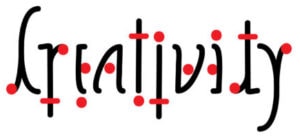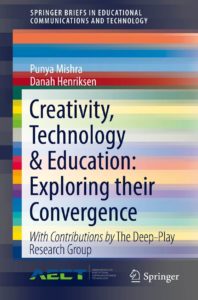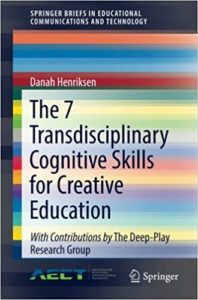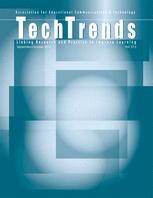
Creativity, any which way you look at it.
Ambigram for “creativity” – symmetric on rotation by 180-degrees.
Creativity has always been a key interest of mine. It is reflected not just in my creative work but also in my scholarship and teaching. Below are some key articles from this line of work.
2 edited volumes that are relevant to this line of work:

The development of a trans-disciplinary framework: Theory, research, practice
In the article below we describe the development of a trans-disciplinary framework for creative teaching using technology, providing a big-picture view of the process of developing a theoretical framework for creative, transformational teaching with digital technology. We describe the transactional nature of the development of our ideas through engagement with research and teaching.
Mishra, P., Henriksen, D. & Mehta, R. (2015). Creativity, Digitality, and Teacher Professional Development: Unifying Theory, Research, and Practice. In In M. Niess, & H. Gillow-Wiles (Eds.) Handbook of Research on Teacher Education in the Digital Age (pp. 691-722). Hershey, PA: Information Science Reference. [Download the article as a PDF]
Abstract: This article describes the development of a trans-disciplinary framework for creative teaching using technology. In recent years, the authors of this paper (and collaborators) have sought to better understand the role of creativity in educational technology. Our approach seeks to inform theory, research, and practice. In this piece we step back to provide a big-picture view of the process of developing a theoretical framework for creative, transformational teaching with digital technology. We describe the development of our ideas over time, through research projects focused on highly creative teachers and their practices. We describe how we have applied these ideas in teacher education courses devoted to creativity and technology, and developed rubrics for evaluating creative products. At a meta-level we aim to provide a rich example of the reciprocal nature of theory, research, and practice in educational technology. Through this we hope to provide one example of how such a theory/ research/ practice development process works, with the goal of informing future work of this type.
Rethinking Technology and Creativity for the 21st Century: Tech Trends Series

An important set of articles is an ongoing series we have written for the journal Tech Trends (one article every 2 months since 2012!) under the broad rubric of Rethinking Technology and Creativity for the 21st Century. (Click the link to see a complete list of articles to download.)
Technology integration, transdisciplinary creativity & learning
Our work on transdisciplinary creativity and learning was first articulated in the article below:
Mishra, P., Koehler, M.J., & Henriksen, D. (2011). The Seven Trans-Disciplinary Habits of Mind: Extending the TPACK Framework Towards 21st Century learning. Educational Technology, 51(2) 22-28.
Abstract: In this article we examine the need for fostering transformative learning, emphasizing the roles that trans-disciplinary thinking and recent technologies can play in creating the transformative teaching and learning of the 21st century. We introduce the Technological, Pedagogical Content Knowledge (TPACK) framework as a starting point for discussing the special kinds of knowledge, skills, and understanding that teachers require in order to become effective classroom mediators of transformative learning experiences. Within this framework, we propose seven cognitive tools needed for success in the new millennium, and describe examples of how teachers can repurpose digital technologies to use these cognitive tools. We explore the implications for research and practice.
